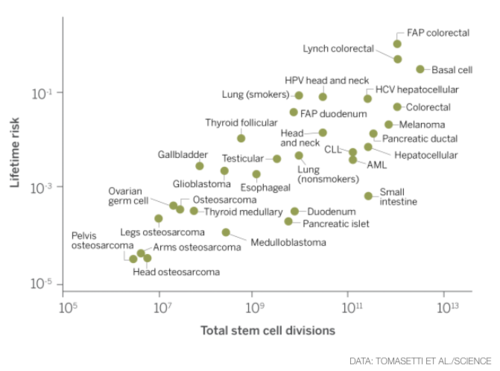Chance News 103: Difference between revisions
| Line 41: | Line 41: | ||
We now see where the two-thirds comes from: if the correlation coefficient <math>r = 0.81</math>, as noted in the abstract above, then <math>R^2=0.66</math>. | We now see where the two-thirds comes from: if the correlation coefficient <math>r = 0.81</math>, as noted in the abstract above, then <math>R^2=0.66</math>. | ||
In response to the controversy, Drs. Tomasetti and Vogelstein (the study's authors), offered some clarifying remarks in an addendum to the original [http://www.hopkinsmedicine.org/news/media/releases/bad_luck_of_random_mutations_plays_predominant_role_in_cancer_study_shows Johns Hopkins news release]. In particular, they construct an analogy with driving a car | In response to the controversy, Drs. Tomasetti and Vogelstein (the study's authors), offered some clarifying remarks in an addendum to the original [http://www.hopkinsmedicine.org/news/media/releases/bad_luck_of_random_mutations_plays_predominant_role_in_cancer_study_shows Johns Hopkins news release]. In particular, they construct an analogy with driving a car: the road conditions correspond to environmental factors, and the condition of your car to hereditary factors; the length of the trip corresponds to the number of cell divisions; and the risk of having an a accident corresponds to the risk of getting cancer. It should be intuitively clear that for any combination of car and road conditions, your the risk of an accident increases with the length of the trip. | ||
'''Discussion''' | '''Discussion''' | ||
Revision as of 21:16, 16 January 2015
Quotations
"[T]he Law of Large Numbers works … not by balancing out what's already happened, but by diluting what's already happened with new data, until the past is so proportionally negligible that it can safely be forgotten." [p. 74]
"'I've been in a thousand arguments over this topic [hot hand],' [Amos Tversky] said. 'I've won them all, and I've convinced no one.'" [p. 127]
"The significance test is the detective, not the judge." [p. 161]
"Correlation is not transitive. …. Niacin is correlated with high HDL, and high HDL is correlated with low risk of heart attack, but that doesn't mean that niacin prevents heart attacks." [p. 342]
Submitted by Margaret Cibes
“Best, Smith, and Stubbs (2001)[1] found a positive relationship between perceived scientific hardness of psychology journals and the proportion of area devoted to graphs. It is interesting that Smith et al. (2002)[2] found an inverse relationship between area devoted to tables and perceived scientific hardness.”
Submitted by Margaret Cibes
Forsooth
Cancer and luck
Cancer’s random assault
By Denise Grady, New York Times, 5 January, 2015
The article concerns a recent research paper, Variation in cancer risk among tissues can be explained by the number of stem cell divisions (Science 2 January 2015). From the abstract
Here, we show that the lifetime risk of cancers of many different types is strongly correlated (0.81) with the total number of divisions of the normal self-renewing cells maintaining that tissue’s homeostasis. These results suggest that only a third of the variation in cancer risk among tissues is attributable to environmental factors or inherited predispositions.
News coverage has created controversy by summarizing the findings in more colloquial terms, similar to this from the NYT article:
Random mutations may account for two-thirds of the risk of getting many types of cancer, leaving the usual suspects — heredity and environmental factors — to account for only one-third, say the authors, Cristian Tomasetti and Dr. Bert Vogelstein, of Johns Hopkins University School of Medicine.
Of course, saying that two-thirds of the variation among cancer types is explained by the rate of cell division is not the same thing as saying that two-thirds of risk of a particular cancer is can be accounted for by chance, or that two-thirds of cancer cases are attributable to bad luck. But these latter misinterpretations have been offered.
The resulting controversy is addressed in
- Bad luck and cancer: A science reporter’s reflections on a controversial story
- by Jennifer Couzin-Frankel, Science Insider, 13 January 2015
This article presents the following data graphic of the relationship
We now see where the two-thirds comes from: if the correlation coefficient <math>r = 0.81</math>, as noted in the abstract above, then <math>R^2=0.66</math>.
In response to the controversy, Drs. Tomasetti and Vogelstein (the study's authors), offered some clarifying remarks in an addendum to the original Johns Hopkins news release. In particular, they construct an analogy with driving a car: the road conditions correspond to environmental factors, and the condition of your car to hereditary factors; the length of the trip corresponds to the number of cell divisions; and the risk of having an a accident corresponds to the risk of getting cancer. It should be intuitively clear that for any combination of car and road conditions, your the risk of an accident increases with the length of the trip.
Discussion
The original headline of the news release was "Bad Luck of Random Mutations Plays Predominant Role in Cancer, Study Shows." Do you think this could have contributed to the misinterpretations? Can you suggest another wording?
Submitted by Bill Peterson
